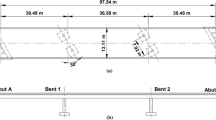Abstract
The seismic behavior of skewed bridges compared to straight bridges is not well recognized and need more study to investigate its unique behavior under seismic forces. Much more damage have seen from skewed bridges particularly when its deck rotates in the earthquake. Many causes are involved in this behavior such as columns and piers nonlinear deformation patterns. Through a Modal Pushover Analysis (MPA) we will assess the inelastic seismic behavior of reinforced concrete bridges those have skew-angled seattype abutments. The angle of skewness will change the seismic behavior of this kind of bridges and in this paper this change is explored with special attention. Maximum nonlinear displacement is sensitive to increase the number of spans and the skew angle of abutments and piers, but the amount of effects are up to number of spans and angle of skewness. This study showed that as the number of spans increases, the deck rotation responses at abutments will be deducted and the adverse effect of skew would subtracted in the bridge.
Similar content being viewed by others
References
AASHTO (2007). American Association of State Highway and Transportation Officials, “AASHTO LRFD Bridge Design Specifications (4th ed.)”, AASHTO, Washington.
Applied Technology Council (2000). [FEMA356, Pre-standard and Commentary for the Seismic Rehabilitation of Buildings, Redwood City, California].
ATC-40 (1996). Applied Technology Council [ATC], Seismic evaluation and retrofit of concrete buildings, Redwood City, California.
Aviram, A., Mackie, K., and Stojadinovic, B. (2008). Guidelines for nonlinear analysis of bridge structures in california, pacific earthquake engineering research center, Technical Report No. PEER 2008/03, University of California, Berkeley.
California Department of Transportation (2013). Caltrans Seismic Design Criteria Version 1.7, Caltrans, Sacramento.
Chopra, A. K. (2015). Dynamics of Structures: Theory and Applications to Earthquake Engineering, 5th Edition, Prentice Hall, Englewood Cliffs, New Jersey.
Chopra, A. K. and Goel, R. K. (2001). “A modal pushover analysis procedure to estimate seismic demands for buildings: Theory and Preliminary Evaluation.” Pacific Earthquake Engineering Research Center, Technical Report No. PEER 2001/03, University of California, Berkeley.
Computers and Structures Inc SAP2000 (2014). Integrated structural analysis and design software, Berkeley, Website: http://www.csiberkeley.com/sap2000.
Elnashai, A. S. and Sarno, L. D. (2008). Fundamentals of Earthquake Engineering, John Wiley & Sons Ltd, (1st ed., p. 347).
FEMA356, Federal Emergency Management Agency (2000). (FEMA, “Prestandard And Commentary for the Seismic Rehabilitation of Buildings”, Washington).
FEMA366, Federal Emergency Management Agency (2008). (FEMA, “HAZUS® MH Estimated Annualized Earthquake Losses for the United States”, Washington).
Ghotbi, A. (2014). “Performance-based seismic assessment of skewed ridges with and without considering soil-foundation interaction effects for various site classes.” Journal of Earthquake Engineering & Engineering Vib., Vol. 13, pp. 357–373, DOI: 10.1061/(ASCE)CF.1943-5509.0000435.
Ghotbi, A. (2015). “Modal pushover analysis of skewed bridges-case study of jack tone road on-ramp overcrossing.” KSCE, J. Civil. Eng., Vol. 20, pp. 1948, DOI: 10.1007/s12205-015-0008-x.
Ghotbi, A. (2016). “Response sensitivity analyses of skewed bridges with and without considering soil–structure interaction.” The Institution of Structural Engineers (Structures 5), pp. 219–232, DOI: 10.1016/j.istruc.2015.12.002.
Isakovic, T., Fischinger, M., and Kante, P. (2001). “Bridges: When is single mode seismic analysis adequate?.” Proc. of the Institution of Civil Engineers Structures & Buildings, Vol. 149, No. 4, Paper No. 12468, DOI: 10.1680/stbu.2003.156.2.165.
Jayaram, N., Shahi, S., and Baker, J. (2010). “Ground Motion for PEER Transportation Research Program.” http://peer.berekeley.edu/transportation/gm_peer_transportation.html.
Jeffrey G. and Franklin Y. Cheng (2011). “Seismic Design Aids for Nonlinear Pushover Analysis of Reinforced Concrete and Steel Bridges (Advances in Earthquake Engineering).” CRC Press.
Kappos, A., Paraskeva, T., and Sextos, A. (2005). “Modal pushover analysis as a means for the seismic assessment of bridge structures.” 4th European Workshop on the Seismic Behavior of Irregular Complex Structure, Thessaloniki, Greece, Paper No. 49.
Kaviani, P., Farzin, Z., and Ertugrul, T. (2014). “Performance-based seismic assessment of skewed bridges.” Pacific Earthquake Engineering Research Center, Technical Report No. PEER 2014/01, University of California, Berkeley.
Kaviani, P. (2011). Performance-based Seismic Assessment of Skewed Bridges, PhD Dissertation, University of California.
Krawinkler, H. and Seneviratna, G. (1998). “Pros and cons of a pushover analysis of seismic performance evaluation.” Journal of Engineering Structures, Vol. 20, Nos. 4-6, pp. 452–464, DOI: 10.1016/S0141-0296(97)00092-8.
Newmark, N. M., Blume, J. A., and Kapur, K. K. (1973). “Seismic design spectra for nuclear power plants.” J. Power Div., ASCE, Vol. 99, pp. 287–303. 99(P02).
Paraskeva, T., Kappos, A., and Sextos, A. G. (2006). “Extension of modal pushover analysis to seismic assessment of bridges.” Earthquake Eng. Struct. Dyn., Vol. 35, pp. 1269–1293, DOI: 10.1002/eqe.582.
PEER (2015). Pacific Earthquake Engineering Research Center: PEER NGA Database, University of California, Berkeley. http://peer. berkeley.edu
Rasouli, S. M. and Mahmoodi, M. (2016). “Comparison between seismic behavior of continuous multiple span skewed bridges with concrete and steel columns.” Asian Journal of Civil engineering BHRC, Vol. 17, No. 6, pp. 753–769.
Wilson, T., Chen, S., and Mahmoud, H. (2015). “Analytical case study on the seismic performance of a curved and skewed reinforced concrete bridge under vertical ground motion.” Engineering Structures, Vol. 100, pp. 128–136, DOI: 10.1016 /j.engstruct.2015.06.017.
Author information
Authors and Affiliations
Corresponding author
Rights and permissions
About this article
Cite this article
Rasouli, S.M., Mahmoodi, M. Assessment the Effect of Skewness and Number of Spans in Seismic Behavior of Bridges with Continuous Multiple Spans Using MPA. KSCE J Civ Eng 22, 1328–1335 (2018). https://doi.org/10.1007/s12205-017-1442-8
Received:
Accepted:
Published:
Issue Date:
DOI: https://doi.org/10.1007/s12205-017-1442-8




